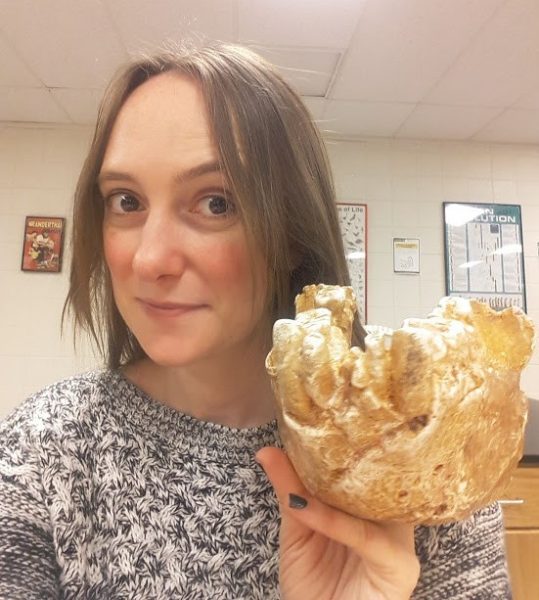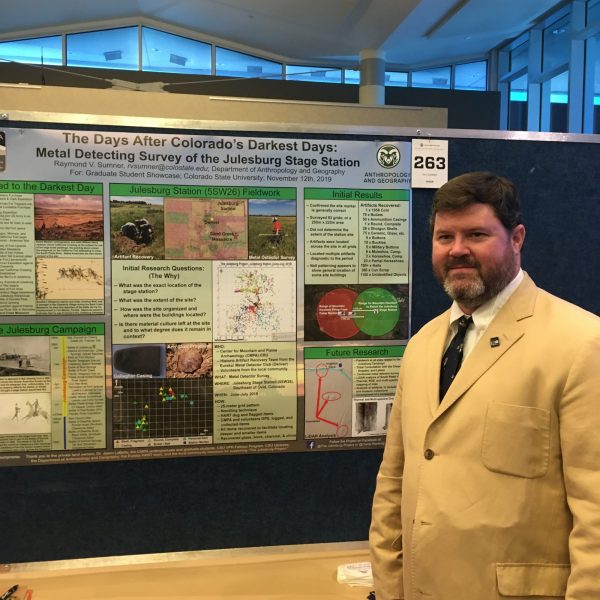Showcase Success for Anthropology Graduate Students
Joshua Zaffos
Anthropology and Geography graduate students garnered accolades and awards at the 2020 Graduate Student Showcase at Colorado State University. Doctoral students Mary Shirley Mitchell and Ray Sumner each won awards for outstanding research and presentations during the virtual showcase in November.
Mitchell’s poster and presentation, titled “Hips, Bones, and Bipedality” earned a Top Scholar Award from the College of Liberal Arts. The honor includes a $500 award.
Sumner won an Honorable Mention from the Great Minds in Research Awards, presented by the Graduate School and the Office of Vice President for Research (OVPR), for his research and poster, “The Days After Colorado’s Darkest Day: Unearthing the Julesburg Campaign.” Sumner has also previously collected College of Liberal Arts outstanding scholarship awards in 2017 and 2018 at the showcase and was named as a OVPR Graduate Fellow for 2019-20.
Our department caught up with Mitchell and Sumner to learn more about their research and their approaches to presenting during the online showcase.
Mary Shirley Mitchell
Explain for non-anthropologists, what is the bicondylar angle and why does it matter?
The bicondylar angle is the angle at which your femur leaves your hip and comes in at the knee, which brings your center of gravity underneath you and allows you to have a smooth gait while walking bipedally. Because this angle only forms due to biomechanical stress vs. genetic coding, when anthropologists find it in a fossil hominin they assume that particular primate walked bipedally. The thing is, no one really knows the mechanics that drive the formation of that angle; the relationships have just been assumed.
It’s also been assumed that wide hips, such as those in Australopithecus, would cause a greater degree of angle by pushing femur heads out further side-to-side. This relationship has also never been tested. If it were true, it would suggest women are worse at walking because we have to balance the biomechanics of bipedality with wide enough hips to successfully give birth and it would cost women more energy to move around.
My research showed that there was no significant relationship between hip width and bicondylar angle, and that the formation of that angle may have more to do with stress on the medial condyle at the other end of the femur. This means that our assumptions may not be correct about the locomotion those organisms used. We need to know more about the mechanics behind the formation of the bicondylar angle before we can truly say what its presence can tell us and conjecture about the origin of bipedality.
Mary Mitchell recorded a presentation of her research for the Office of the Vice President for Research’s 3-Minute Challenge in February 2021.
How did you come across this topic for your research?
One of my committee members for my Master’s Thesis (and all-around awesome dude) was Dr. Caley Orr, who teaches anatomy at University of Colorado Anschutz Medical Campus. He studies functional morphology in hominins and started me on this path. Later, I was lucky enough to study under the tutelage of Dr. Anna Warrener (an all-around awesome lady) at UC Denver whose doctoral research was all about the obstetrical dilemma [this is the hypothesis that explains why humans often need help from others during childbirth to safely deliver a baby while most non-human primates can give birth unassisted].
I really liked the combo of investigation, evolution, and feminist theory that overlapped in talking about bipedalism and the bicondylar angle, and the more I studied how the pelvic complex works the more fascinating I found it all.
“I love bones! When you get the chance to draw information from them, it’s like uncovering a secret language that only a few people can speak and you are lucky enough to be one.”

What’s most fascinating to you about your work?
I love bones! When you get the chance to draw information from them, it’s like uncovering a secret language that only a few people can speak and you are lucky enough to be one. The most fascinating part of the work for me is that act of translating the shape and size of calcium carbonate into real world information about the life of an individual. I just think that is so cool.
You seemed to have fun with your recorded Showcase presentation. How did you approach this virtual pitch and what make you want to share biological anthropology with others?
I hold dear the notion that science belongs to everyone. My undergraduate degree is actually in Theatre, which I believe serves me well in translating complex ideas into digestible information for people who aren’t indoctrinated in it.
While it’s great and important to be able to converse with your peers, unless you can share with the world why it excites and engages you I don’t see much point in doing research. Most people are naturally curious and it isn’t that difficult to engage that curiosity, but it is extremely easy to get lost in the minutiae and lingo and forget how to make your work consumable for the public.
It’s a vital and often underrated skill you have to constantly be practicing. It helps that I really love what I do!
#######
Ray Sumner
How did you end up studying this topic and moment in history?
In September 2018, Dr. Jason LaBelle and I attend the 150th Commemoration of the 1868 Battle of Beecher Island. [The three-day skirmish took place along the Arikaree River in northeastern Colorado between the U.S. Army and the Arapaho, Cheyenne, and Sioux tribes.] On the return trip to Fort Collins, we stopped at the Julesburg Museum and drove by the stops on the South Platte River Trail Byway that include the Battle of Julesburg battlefield, Fort Sedgewick, and the stage station along the Overland Trail.
[The Battle of Julesburg occurred on January 7, 1865 when Arapaho, Cheyenne, and Lakota Sioux soldiers and warriors attacked Julesburg and Fort Rankin (later renamed Fort Sedgewick) in direct response to the infamous Sand Creek Massacre, just weeks earlier. The tribes attacked Julesburg again on February 2.]
As I was looking for a dissertation focus area, I realized how little the events at Julesburg had been studied, and it quickly evolved into the logical choice for my dissertation research. It combined my previous career as a U.S. Army Officer with my training as a western and public historian with my current academic training as an archaeologist/anthropologist.
Because it is so little understood I have started branding it as research into “The Days after Colorado’s Darkest Day” with the Sand Creek Massacre obviously the darkest day. My research is trying to tell the story of what happened next.

Your project examines how tribes may have coordinated their attacks in the weeks and months following the Sand Creek Massacre of November 29, 1864 (when the Third Colorado Cavalry attacked an encampment of tribes in southeastern Colorado and killed and mutilated hundreds of Native Americans, mostly women and children). What have you found through your research?
I am still tweaking the argument, but I am arguing that the events of 1865 should be viewed or contextualized as a Native American military campaign, especially the events of January-February 1865 in Colorado and Nebraska. Specific to what happened in Colorado along the Overland Trail between the two battles, it becomes clear that these were coordinated events when you walk through the sites.
My initial work has been applying Military Theory to the events and seeing them how I would as a military planner. Looking at them through this frame of reference, the events are clearly coordinated throughout 1865. I am trying to use the ethnohistory and ethnology to better understand the organization of the Native Americans to put the individuals back into the story. This will also help show how the events are related as it is the same people conducting them.
For the initial Battle of Julesburg in January 1865, it was far more complex than just a revenge attack on the station. The warriors attacked two stages and wagon trains to draw out military into a kill zone far east of their post. They then forced the military back into their fort in full retreat. They harassed the fort but didn’t try to take it despite their having the force to overrun it. Instead, the tribes took supplies from the stage station’s warehouse.
The tribes came back to Julesburg for the last time on February 2, 1865 and, this time, broke up the road into sectors each attacking a different area. After driving off the civilians, stock, and then isolating the military, the tribes raided the warehouses for a second time and then set fire to the buildings.
This has kept my attention as it is a story that is fascinating and needs to be told. Work in this area shows that key individuals in the “Indian Wars” throughout the 1860s and 1870s were at Julesburg on January 7, 1865 or February 2, 1865, including Crazy Horse, Tall Bull (killed at Summit Springs in 1869), Roman Nose (Killed at Beecher Island in 1868), Spotted Tail, and Pawnee Killer.
“I realized how little the events at Julesburg had been studied, and it quickly evolved into the logical choice for my dissertation research. … This has kept my attention as it is a story that is fascinating and needs to be told.”
The range of tools you are using to map and find evidence is also pretty fascinating and spans technologies.
I am using GIS (geographic information systems mapping), field mapping, and metal detectors heavily in my work for understanding the whole battle including the movements and actions of the Cheyenne, Arapaho, and Lakota along with the U.S. Army and civilians in the area. Most of the artifacts found so far relate to the U.S. Army – bullets, uniforms, casings, artillery fragments – so the understanding of the Native American movements is implied from what these artifacts represent of the US Army’s movements.
I am making high-definition digital maps as well as thermal and multi-spectral maps of the battlefield using drones. I am also, of course, making maps of all the artifacts recovered. This all is used to understand the battle.
You hint at some misperceptions of the tribes’ response so what did you discover to strengthen what we do know about that time?
The misrepresentation is maybe better put as an oversimplification that the events along the Overland Trail in early 1865 were revenge. Putting things together, I think it becomes clear the Cheyenne, Lakota, and Arapaho were conducting operations to resupply the victims of Sand Creek for the winter and to disrupt the U.S. Army and emigrants coming into their lands. Sure, there was retribution, but that was not the primary objective.
What’s most exciting or fascinating to you about your findings?
The most fascinating finds so far, in terms of artifacts, are the four fragments of artillery shells that we located in 2019. Due to the records and historical accounts, we can say with high probability the 12-hour period in which they were fired. That precision is obviously rare in dating items in archaeology. An 1858 U.S. One Cent Piece located at the same site is also a close second. It is in great condition for being in the ground so long.